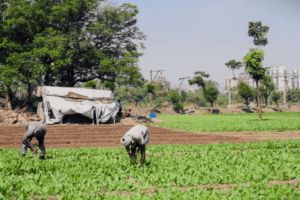While there is an increasing interest in using carbon credit mechanisms to strengthen climate change mitigation, a lot more needs to be done to educate different stakeholders on how it works in practice. In this blog, Lakshman Rodrigo and Enoka Munasinghe illustrate the process of carbon trading in the context of agriculture and how it could be used to encourage reduction in greenhouse gas emissions.
CONTEXT
Unpredictable and life-threatening incidents taking place frequently due to extreme weather events such as protracted droughts, high intensity rainfall with floods and cyclones, has convinced the majority that Climate Change is certainly not a myth. Increase in Greenhouse Gases (GHGs) – Carbon dioxide (CO2), Methane (CH4), Nitrous oxide (N2O), Hydrofluorocarbons (HFCs), Perfluorocarbons (PFC) and Hydrofluoroethers (HFEs) and more – in the atmosphere has led to mounting temperature caused by the trapping of infra-red radiation emitted by the earth’s surface. This has been disturbing the atmospheric equilibrium resulting in extreme weather events. Further, there is uncertainty about the temperature level which would create irreversible damage (the so-called ‘tipping point’). However, expecting that to happen sooner or later, world leaders have been forced to come to a consensus in finding effective solutions for bringing down the levels of GHGs in the atmosphere. But for achieving the necessities of day-to-day life, GHG emissions are inevitable; obviously, everyone cannot bring down their own emissions to zero. Therefore, pragmatic approaches are to be urgently found to address this in the right manner.
CARBON TRADING?
Carbon trading refers to the transaction of carbon credits. On the one hand, it allows the accumulation of carbon credits by reducing GHG emissions, i.e., avoidance credits (for example, through renewable energy projects to replace fossil fuel burning) or by directly fixing the atmospheric GHGs, i.e., by removal credits (e.g., CO2 fixations in forestry projects). On the other hand, it permits entities that cannot bring down their emissions to zero, to purchase carbon credits for neutralizing/offsetting their own emissions. This they can do through carbon trading, which is the buying and selling of credits that permit an entity to reduce emissions of GHGs as a monetary deal to compensate the emissions of another entity – to a certain amount – so as to achieve carbon neutrality. This is illustrated in Figure 1.
Accordingly, the entity in ‘Situation 1’ has been able to fix additional amount (x) of GHGs over the emissions generated from non-renewable sources (i.e., c1-b1= x). This is the amount to be considered as carbon credits. Having lesser, or with zero amount of GHG fixed but with emitting GHGs generated from non-renewable resources (i.e., c2<b1), the entity in ‘Situation 2’ has become a net emitter. However, it can offset its additional emissions through the purchase of carbon credits from an entity in ‘Situation 1’.
 Figure 1: Schematic illustration of carbon trading for carbon neutrality/net zero
Figure 1: Schematic illustration of carbon trading for carbon neutrality/net zero
Standardization of GHGs is important in quantifying their emissions or removal from the atmosphere, and furthermore to build up the credits for transactions. Being the most determining GHG in climate change, effects of all GHGs are benchmarked against that of carbon dioxide; hence, the term ‘carbon’ is used as a synonym for all GHGs. It means carbon trading is common to all GHGs and quantification of carbon credits is done by considering the unit potential for global warming with the benchmark value of ‘1’ for 1 ton of CO2. Having greater unit potential for global warming, other most important GHGs are, for instance, 1 ton of CH4 and N2O bear the value of 28 and 265 respectively, relative to CO2. Accordingly, while 1,000 tons of CO2 provides only 1,000 credits, the 1,000 tons of CH4 are equal to 28,000 carbon credits.
|
Box 1: Origins of carbon trading |
Carbon Footprint and Carbon Neutrality
Net amount of GHG emissions in terms of CO2 equivalent as described above (CO2e) of an entity in whatever level (i.e., product / service/ process/ organization) is commonly named as ‘Carbon footprint’ and this is what is offset in carbon trading. In the estimation of GHG emissions for achieving carbon neutrality, emissions within the functioning boundary of the entity (Scope 1) and also emissions involved in energy generation in upstream (Scope 2) are usually measured. However, in achieving the Net Zero status, GHG emissions in both upstream and downstream activities in the value chain (Scope 3) are to be considered.
For instance, in crepe rubber manufacturing in Sri Lanka, only about 14.1 kg of CO2e per 1 ton of rubber is emitted under Scope 1 whilst upstream emission for the electricity used for the same accounts for 247.3 kg of CO2e (Scope 2) (Dunuwila et al. 2018). A part of the Scope 3, i.e., upstream emissions associated with chemicals and polythene use, have also been assessed in this study accounting for 17.9 CO2e per 1 ton of crepe rubber (Dunuwila et al. 2018).
Carbon neutrality and Net Zero have become environmental and social obligations. Similarly, in marketing, it has become important while branding companies or actions. For instance, Marks & Spencer, a retailing giant, has become carbon neutral since 2007. In Sri Lanka, Commercial Bank achieved carbon neutrality for the entirety of its operations by 2020. In Europe, over 60% buy only environmentally-friendly products, or try to do so as much as possible; 21% of the younger respondents (aged 16-25) are willing to pay higher prices for environmentally-friendly products, according to the market research institute Appinio (https://www.climatepartner.com/en/news/climate-awareness-report-2021-consumer-survey).
Building up a project for carbon credits to be utilized for own carbon neutrality (called ‘in-setting’) is not as difficult as establishing a project for carbon trading (i.e., for off-setting the emissions of another entity). In the business world, the latter is the enticement. Amidst such demand for carbon credits, most expect to build up projects to generate carbon credits. Nevertheless, not from a business angle but on empathetic grounds to support resource poor farmers, we have built up a carbon trading project in the voluntary market with 3,000 ha of newly planted rubber in Monaragala and Ampara districts of Sri Lanka. (https://registry.verra.org/app/search/VCS/All%20Projects). It is expected to generate about 1.7 million carbon credits, and financial gains will be utilized for community benefit of farmers and also for further expansion of rubber cultivation in remote areas of Sri Lanka.
 Rubber plantations have large potential to sequester atmospheric carbon into the biomass and soil.
Rubber plantations have large potential to sequester atmospheric carbon into the biomass and soil.
OPERATIONALISING CARBON CREDITS
Carbon trading projects are in operation under two marketing systems, Compliance market and Voluntary market. The former is in the hands of governments and the latter, as the name describes, is open for anyone. At present, the biggest share of carbon trading is with Compliance market; however, Voluntary market is rapidly expanding with wide participation. While new trading systems are emerging in different countries, some of the major systems under the Compliance market are: European Union’s Emissions Trading System, California Global Warming Solutions Act (in USA), and Chinese National Emission Trading System. Prominent registries in the Voluntary market are: Verra, Gold Standard, Climate Action Reserve, the American Carbon Registry, and Plan Vivo.
Key Criteria in Carbon Trading
The most important criterion to be considered in building up carbon project is the limiting of emissions or fixing CO2 instead of continuing with the business as usual attitude. Therefore, claiming for carbon credits in any ongoing work cannot be considered though such work may provide a cap to GHGs. Financial additions are also to be proven through benefit cost analyses showing that without the funds generated from carbon trading, the project objectives cannot be met.
Further, solid evidence is to be provided to ensure the reality and permanency of carbon credits generated. Should the project aim to address a unique issue, it will become more attractive and get high value in the carbon market.
Process Of Developing a Carbon Trading Project
Once the concept is built up (keeping in mind the above-mentioned criteria) as a Project Idea Note (PIN), a project description document is to be prepared as an evidence-based detailed report and submitted to a suitable Registry for listing. Then the project documents are opened for public review, and the project is to be validated by an accredited body of the relevant Registry. If validators and the Registry are satisfied with the project, it will be registered. Then, from time to time the verification on carbon credits is to be done again by an accredited body of the relevant Registry.
Accredited validation and verification bodies are usually named as VVBs. To ensure transparency in the procedure, the project cannot continue with the same VVB always, so it has to be changed periodically as per the guidelines of the Registry. After each successful verification, carbon credits are issued, and those are the marketable units used in lieu of (for offsetting) the carbon emissions in other entities. Once used for offsetting, these carbon credits retire and have no value for further exchange.
For the above process, several fees are to be paid to the Registry for their service. It may include listing in the registry, registration, annual maintenance of accounts and issuance of carbon credits. Also, expert knowledge is required for documentations and to establish transparency and traceability of project activities. Since everything in the process has a cost, it is always necessary to establish large scale projects for carbon trading. Therefore, for small scale projects, combining similar type of projects is good (i.e., bundling) so as to make the carbon trading financially viable. Carbon credits have no fixed value, its market value depends on the quality which is assessed in terms of other social and environmental benefits. Therefore, projects are to be built up not specifically for carbon credits but with wider facets that can benefit people and the entire planet.
END NOTE
Implications for Extension and Advisory Services
With the experience gained from the rubber-based carbon trading project established in Sri Lanka, we believe that carbon trading is a pragmatic approach to support community-based tree planting programmes. Smallholder farmers usually go for agroforestry systems that allow net fixing of atmospheric CO2 whist meeting their socio- economic needs. Although those lands are eligible for carbon trading, the extent at individual or cluster level is insufficient for building up a carbon trading project. Joining with a carbon project developer, extensionists could assist to bundle farmers for obtaining reasonable extent (i.e., over 2,000 hectares) to build up a project – if the general mechanism of carbon trading is known to them. Further, their support could be taken for field establishment and monitoring land lots as well as for identifying real needs of farmers that can be addressed through monitory gains from carbon credits. Thereby, extensionists could have a break from the traditional extension pathway and support the farmers more effectively.
Literature Cited
Dunuwila P, Rodrigo VHL and Naohiro Goto. 2018. Financial and environmental sustainability in manufacturing crepe rubber in terms of material flow analysis, material flow cost accounting and life cycle assessment. Journal of Cleaner Production 182:587-599.
For Further Reading
Dunuwila P, Rodrigo VHL and Naohiro Goto. 2020. Improving financial and environmental sustainability in concentrated latex manufacture. Journal of Cleaner Production 255:120202.
Energy Information Administration. 2011. Annual Energy Review. Independent Statistics and analysis. United States. https://www.eia.gov/totalenergy/data/annual/showtext.php?t=ptb0802a
International Standard. 2018. ISO 14064-1, Greenhouse gases — Part 1: Specification with guidance at the project level for quantification, monitoring and reporting of greenhouse gas emission reductions or removal enhancements. https://seors.unfccc.int/applications/seors/attachments/get_attachment?code=G5LLGEM3QRJ5JKYFKL8YDMUO8I04H6HO
Kumara PR, Munasinghe ES, Rodrigo VHL and Karunaratna AS. 2016. Carbon footprint of rubber/sugarcane intercropping system in Sri Lanka; A case study. Procedia Food Science 6 (2016):298-302.
Munasinghe ES and Rodrigo VHL. 2021. Carbon trading for the sustainable rubber industry. Pages 290-300 in: Handbook of rubber. Volume 1, Agronomy (Rodrigo VHL and Seneviratne P, eds.). Rubber Research Institute of Sri Lanka. Agalawatta. (ISBN 978-624-5806-01-0).
United Nations Environment Programme. 2022. The Emissions Gap Report, United Nations – Environment. https://www.unep.org/resources/emissions-gap-report-2022
United Nations Framework Convention on Climate Change. 2015. The Paris Agreement. The Climate Analytics. United Nations – Climate Change. https://unfccc.int/process-and-meetings/the-paris-agreement
 Lakshman Rodrigo pioneered to build up the rubber-based forestry project in Sri Lanka for volunteer carbon market with Enoka Munasinghe. He was the former acting director of the Rubber Research Institute of Sri Lanka (RRISL), and presently serves as the Scientific Director from ICRAF to the GCF Knuckles Project in Sri Lanka. Email: L.Rodrigo@cifor-icraf.org
Lakshman Rodrigo pioneered to build up the rubber-based forestry project in Sri Lanka for volunteer carbon market with Enoka Munasinghe. He was the former acting director of the Rubber Research Institute of Sri Lanka (RRISL), and presently serves as the Scientific Director from ICRAF to the GCF Knuckles Project in Sri Lanka. Email: L.Rodrigo@cifor-icraf.org
 Enoka Munasinghe is presently the lead scientist in carbon trading, and also serves as Principal Research Officer at the Adaptive Research Unit at RRISL. Email: enokamunasinghe@yahoo.com
Enoka Munasinghe is presently the lead scientist in carbon trading, and also serves as Principal Research Officer at the Adaptive Research Unit at RRISL. Email: enokamunasinghe@yahoo.com





Extensionists are the people whom farmers can rely on for new information and development happening in the agriculture sector. But when extensionists themselves are ignorant of the new concepts like carbon credit, where will farmers look for such information? It is in this context, this kind of blogs come handy to orient extensionists in emerging developments. The AESA & authors of the blog deserve high appreciation for bringing out this well written blog which explains what, why and how of carbon credits lucidly. Also, it is appreciable that professionals from different countries in the region are contributing content for the benefit of AESA membership and others.